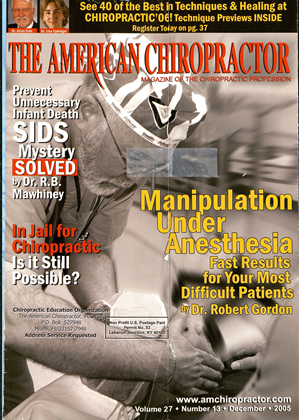A recent paper released by the ICA Pediatrie Council and written by Dr. Joan Fallon, "A matrix for chiropractic care," has many family practitioners up in arms about its validity and intent. The following is a brief response from the International Chiropractic Pediatrie Association's Research Director, Dr. Joel Alcantara. It is important to note that the International Chiropractic Pediatrie Association (ICPA) is the oldest and largest pediatrie organization and is separate and distinct from the ICA Pediatrie Council. The chiropractic care of children has been an integral part of the practice of chiropractic since its inception. However, only relatively recently has pediatrie chiropractic been considered a new specialty as highlighted by textbooks, specialized post-graduate programs as those offered by the International Chiropractic Pediatrie Association and the publication of a peer-reviewed journal specifically addressing the needs of children. A recent article by Fallon1 published in the Journal of Clinical Chiropractic Pediatrie provides a "matrix for chiropractic care" of children. It is important to note that Fallon is associated with the ICA Pediatrie Council, which is not affiliated with the International Chiropractic Pediatric Association. The matrix provides for seven categories of care with specified treatment frequencies. The following is a short critical appraisal of her article. Similar to all healthcare providers, chiropractors face various clinical decisions to provide the most appropriate care. Nowhere is this more true than in the practice of pediatric chiropractic. How much care should children receive? What is too much? What is not enough? What arc the limits and what are the needs? What frequency of care should one recommend to parents? Why docs the child need care? Such challenging questions give rise to clinical guidelines and, as defined by the Institute of Medicine,1 they are "systematically developed statements to assist practitioner and patient decisions about appropriate health care for specific clinical circumstances." Clinical guidelines have the potential benefit of improving health outcomes in patients and they do improve the quality/appropriateness of clinical decisions. On the other hand, clinical guidelines have limitations and have potential harms. Herein lies the critique of Fallon's matrix of care for children. Like Fallon's matrix of care, guidelines may be wrong. For one thing, although the scientific inquiry on the chiroprac- tic care of children is in its infancy, a number of research endeavors have been published in scientific journals. Fallon's review of the literature to support her matrix of care is lacking, misinterpreted and ultimately, misleading. Secondly, clinical guidelines are rigorously developed by experts in the field. From what could be discerned, Fallon's matrix of care is more of an opinion-piece, presumably based on her clinical experience. Her matrix of care has no clinical rationale from a chiropractic perspective. The categories of care are whimsical and have no clinical precedent from which to provide an authority or judgement with respect to treatment frequencies. They do not take into account the detection and correction of spinal and extra-spinal subluxations. Rather, they focus on condition-based care for which treatment frequencies arc arbitrarily assigned instead of a rigorous review of all the available literature. Ultimately, Fallon's matrix provides for subopti-mal, ineffective and potentially harmful chiropractic care. As for the publication of Fallon's article in the Journal of Clinical Chiropractic Peclialric, I question the peer-review process. It is obvious that peer-review was lacking in this case, as exemplified by the inclusion of something as simple as "a fall" being denoted as a condition of care. The peer-reviewers should have weighed the harm versus the benefits that such a poorly written article may have on the practice of pediatric chiropractic. Dr Jeanne Ohm instructs internationally on the topic "Chiropractic Care for Pregnant Women and Children ". She is executive coordinator of the International Chiropractic Pe-diatric Association and can be reached via their website at www. icpa4kids. com. Reference 1.Field MJ. Lohr KN, eds. Clinical practice guidelines: directions tor a new program. Washington, DC: National Academy Press. 1990. Speaker At fCHI^PRACTIC'06... February 12-18,2006 JJl Iff*
 View Full Issue
View Full Issue






